
With an average person receiving 126 emails per day, it is easy for messages to get lost in the crowd. So, if your subscribers haven’t engaged with your messages in a while, the chances are your messages are getting lost in the noise or maybe your subscriber isn’t interested in hearing from your brand anymore. It is just that they haven’t unsubscribed yet.
This is where re-engagement emails can come in handy. From letting your subscribers know what they are missing out to encouraging them to come back to your brand, re-engagement emails help you do it all.
What is a re-engagement email?
Before delving deep into the re-engagement strategy, let’s understand what re-engagement emails are all about. A re-engagement email is also known as reactivation email. It is a type of triggered email that depends and works on a particular stage of a customer life cycle. It is the second most popular kind of triggered campaign among brands.
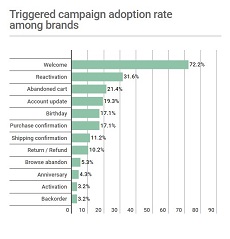
What are the reasons for customer disengagement?
The next step is to decipher the varied reasons for customer dissatisfaction. Remember, not every subscriber disengages because of the same reason. So, before you go ahead and plan your re-engagement strategy, you need to find out why your subscribers aren’t engaging with your brand. Here are a few things to keep in mind.
- If a customer subscribed to your brand for an offer or gift, they might get disengaged after they received the goods.
- Inactive subscribers who have abandoned their shopping carts might be dissatisfied with your prices, payment, or checkout process.
- If a lot of people from the same background or demography are disengaging from your business, it means you are unable to meet the needs of all your customer segments.
Now, since you know the various reasons for customer disengagement, it will help you customize your re-engagement email in accordance with the needs and preferences of customers. Here’s a look at 5 tips that would help you craft an impeccable re-engagement email.
- Remind your customers of the value your email can provide
The main objective of a re-engagement email is to garner the interest of your subscribers back. However, before you do that, it is imperative to understand what your subscriber base wants to extract out of your relationship with them. Are they looking for product updates? Do they want email-only deals? Are they interested in reading a curated list of amazing articles? Once you find out the answer, leverage re-engagement email to remind your subscriber base of the value they can get through your email.
Here’s a re-engagement email template example from Android Authority on a similar line. They try to re-engage their subscribers through a subject line that reads “Are you there”? It helps them understand if the subscriber is still interested in hearing from them. They go ahead and remind the subscribers what they can get with the subscription. From Android news and giveaways to reviews and deals, they include everything in their email copy. They also go a step ahead and give subscribers the option to update their email preferences or unsubscribe from the list in case they are not interested at all.
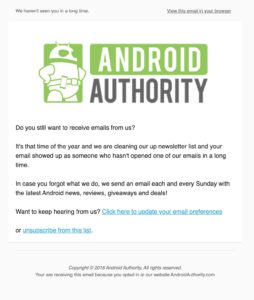
- Give them an option to choose
Giving your subscribers an option to choose is a great way of re-engaging. It makes customers feel that you care about their opinion and feelings. This is where opt down or email preference centre option can come in handy. Maybe your customer base isn’t interested in your product updates or offers but look forward to engaging with your webinars and ebook emails that you send. So, giving them the option to stay subscribed to the email of their preference can be a good re-engagement strategy. You can take some inspiration from the custom email template design of Animoto.
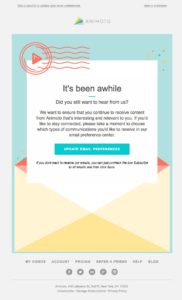
- Maintain your brand’s consistency
A business’s distinct brand personality is one of the major reasons for customer engagement. So, if you don’t maintain your brand’s consistency and send out boring re-engagement emails, the chances of unsubscribers become higher.
We love the way Really Good Emails does a great job with its re-engagement email. See how they make sure the information they have about their subscriber is correct to give them a more personalized approach. Also, the look and the feel of the email copy has the trademark RGE personality – relevant, conversational, and quirky.
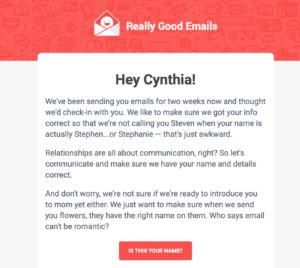
- Let your subscribers know what they are missing out
It is easy for customers to forget why they subscribed to your emails. Maybe they were interested in your product and service earlier but aren’t interested anymore. Maybe they signed up for leveraging a one-time deal. Whatever is the reason, the bottom line is your subscribers might have forgotten the sole purpose of signing up to your emails. That’s why it becomes critical to remind them about the same through a re-engagement email.
See how Udemy makes good use of re-engagement email and gives a friendly nudge to their inactive subscribers by reminding subscribers about the things that come with this subscription – exclusive deals, course updates, and personal recommendations. They also go a step ahead and include an incentive where they offer the subscriber the next course for $10 if they confirm their email subscription.
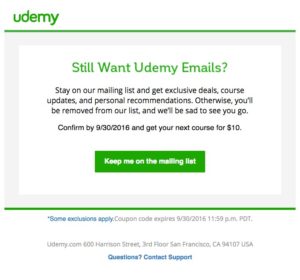
- Ask your subscribers about their interests
At times, it is difficult to understand what your subscribers want out of your emails. So, instead of being clueless and assuming things, it is better to let your guards off and ask the subscribers themselves.
That’s exactly what Bespoke did in its re-engagement email template design. They asked their subscribers about their interest through a subject line “Turn our boxes into your boxes”. They gave each subscriber to mark their interests out of the four options available. It is a great way of customizing emails that’s not only relevant but also resonates with the subscriber base.
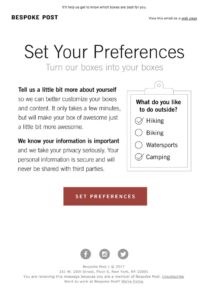
Wrap up
While attracting new subscribers can cost a business $55.24 per contact, businesses that invest in re-engagement campaigns witness a $28.50 return on every $1 spent. You see how retaining an existing subscriber is cheaper than acquiring a new one?
So, go ahead, make use of the above-mentioned tips and start re-engaging your dormant subscribers right away. Give them options. Maybe they have lost interest in you. Maybe they are looking for something better. Further, the length and frequency of your emails can also be an issue for many.
Regardless of the reason, you must know that dealing with email churn isn’t difficult. All you need to do is find the best way to reach out to your customers and entice them to come back to your brand through timely, relevant, and personalized re-engagement emails.
Author Bio
Kevin George is Head of Marketing at Email Uplers, one of the fastest growing custom email design and coding companies that specializes in professional email template creation and PSD to HTML email conversion; they are Mailchimp email experts. Kevin loves gadgets, bikes, jazz and eats and breathes email marketing. He enjoys sharing his insights and thoughts on email marketing best practices on his blog.






